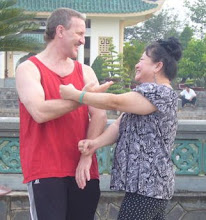It's not a matter of "style" or system, but a matter of the nature of the training. In most systems, you simply stop learning after you reach instructor level. In Wing Tsun, that's where you start learning for real. Before then, training is just a matter of giving you the tools you need. After you make it to instructor level, you learn how to use all of those tools, reflexively, instinctively, according to what your attacker is actually trying to do to you you.
Translated into Wing Tsun terms, you are an instructor once you have learned the first two (out of of three total) empty hand forms (called "Siu Nim Tau" and "Chum Kiu"), and digested the first four sections of "chi sao" ("clinging arms" training) applying the movements of the forms and combining them with basic fighting footwork. Later, you learn the third form ("Biu Tze") while completing the remaining two sections of Chum Kiu chi sao. five chi sao sections that go along with it, and making all of the above fluid and purely reflexive. Then come five sections of Biu Tze chi sao, and finally the Wooden Dummy form with its four chi sao sections.
The Wooden Dummy training is the last phases of empty hand practice. When you can deliver all of that in a fluid and reflexive way during free fighting, you progress to the two weapons forms in Wing Tsun: Long Pole and "Bart Cham Dao", which are a short form of double broadswords. Bart Cham Dao training has the most advanced footwork in it, but of course you learn elements ofthat mmuch earlier in your training because - after all - you are supposed to learn how to fight, right? There's no point in holding it back. There are only different contexts of that footwork that won't be taught until you have understood and mastered a lot of the other techniques.
Naturally, there is also the "chi gerk" or clinging legs training in which you learn to defend and counter attacks to your lower body with your legs while you continue to fight with your arms "upstairs". All of that should take no more than five years, max, if you train hard.
So, at the end of all that, are you "done"?
No. Not by far.
Once you make it through the whole system, you circle back to the first form, Siu Nim Tao, and discover that it was actually the "last" form in Wing Tsun (in terms of when it was developed) because it has elements of all of the other forms in it. It was just put "first" because that helps beginners get a foundation and a frame of reference for everything that is to come. So, once you "finish" the system, you have only completed your first cycle, and you go back to Siu Nim Tau and recognize, for the first time ever, how much of the most advanced concepts in WT are already in there. From there, with your new understanding of what is actually in these forms and how to apply it, you go back through Chum Kiu and Biu Tze, the Dummy and Weapons forms and training again, and again, developing an ever higher level idea of what these are really all about. Naturally, this time it won't take you five years to get through it because you have long since become an instructor yourself.
In the process of all this, you literally and truly make Wing Tsun a part of you. That process becomes an endless cycle. Every time you cycle through the system, you go one step higher - and higher - and higher still. It never stops. That's why it's called "wing tsun". That Chinese name for this art can be translated into English as "eternal springtime" or "forever young" because you will never stop growing. You are always new, and so is your ever brand-new, personal brand of ... well, some call it "wing tsun", but in the end it's just -- you.
Monday, March 28, 2011
Tuesday, March 1, 2011
Subscribe to:
Posts (Atom)


